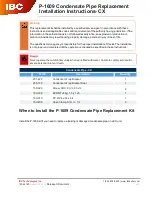
41
9 - START UP PROCEDURE
2.
Perform combustion test on HIGH fire using calibrated
combustion analyzer. Adjust CO2 to within specifications by
rotating the Throttle Screw, counterclockwise
to increase
CO2 level, clockwise
to decrease CO2 level. See Figures
9-3, and 9-4.
After adjusting CO2 to correct level, verify:
(1) CO PPM level is in specified range and
(2) flame signal is in specified range.
See Appendix A page 78.
CO2 level, CO PPM level, and flame signal for HIGH fire
are given in the following tables.
HIGH Fire Combustion - 299 MBH
Gas
CO2
CO
Flame
signal
Min
Max
Design
Target
μA
Natural Gas
9.0%
9.3%
9.3%
<200ppm 6.5 – 7.5
Propane
10.0% 11.0
10.5%
HIGH Fire Combustion - 50/75/100/150/200 MBH
Gas
CO2
CO
Flame
signal
Min
Max
Design
Target
μA
Natural Gas
9.0%
9.5%
9.5%
<200ppm 6.5 – 7.5
Propane
10.0% 11.0 11.0%
3.
Switch to LOW fire in boiler System Test. On user
interface push Enter. “HIGH power” starts flashing. Scroll
down to “Low Power”. Push Enter. “Low Power" stops
flashing and becomes solid. Boiler is now locked in LOW
fire.
Adjust Offset Screw slowly and
in small steps, no more than 1/8
of a turn each time. See Figures 9-5 and 9-6.
Perform combustion test on LOW fire using calibrated
combustion analyzer. Adjust CO2 to within specifications
by turning Offset Screw, clockwise
to increase CO2
level, counterclockwise
to decrease CO2 level. After
adjusting CO2 to correct level, verify
(1) CO PPM level is in specified range and
(2) flame signal is in specified range.
CO2 level, CO PPM level, and flame signal for LOW fire see
following tables.
FIGURE 9-3 Gas Valve - Models
050/075/100/150/200 MBH
FIGURE 9-4 Gas Valve - Model 299 MBH
Throttle Screw
Throttle Screw
WARNING
Fire, explosion, asphyxiation and electrical shock
hazard. Read this instruction and understand all
requirements, including requirements of authority
having jurisdiction before making adjustments. Failure
to follow these instructions could result in death or
serious injury.
!
Note
PN 240011320 Rev. G 10/01/2021]
















































